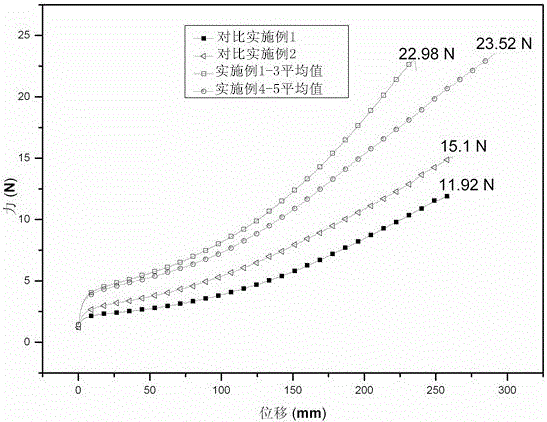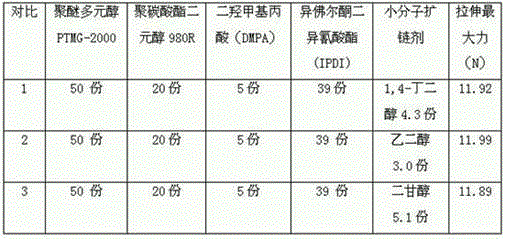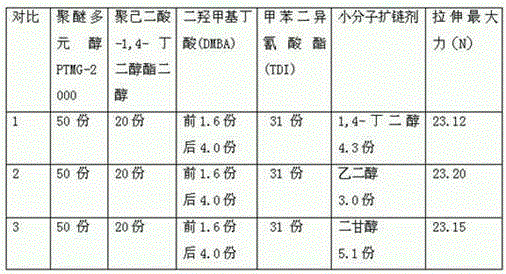A production process of waterborne polyurethane coating with high tensile coating film
A water-based polyurethane and production process technology, applied in polyurea/polyurethane coatings, coatings, etc., can solve the problems of brightness, fastness, dry and wet rubbing resistance, etc., achieve full hand feeling, good compatibility, and increase molecular weight Effect
- Summary
- Abstract
- Description
- Claims
- Application Information
AI Technical Summary
Problems solved by technology
Method used
Image
Examples
Embodiment 1
[0029] Example 1: Add 50 parts of polyether polyol PTMG-2000, 20 parts of polyadipate-1,4-butylene glycol ester diol, and 1.6 parts of dimethylol butyric acid (DMBA) into the reaction flask, and heat After reaching 78°C, add 31 parts of toluene diisocyanate (TDI), cool down to 70°C and continue the reaction for 25 minutes; add 1,4-butanediol (BDO) (the type of small molecule chain extender can vary, see Table 1) 4.3 After that, heat up to 80°C and keep it warm for 25min; then add 4.0 parts of dimethylolbutyric acid (DMBA) again, and increase the reaction temperature to 85°C for 25min; take a sample to measure the NCO % value, if it does not reach the theoretical value, then Raise the temperature to 90 °C; after reaching the theoretical NCO % value, add ethylene glycol dimethyl ether-acetone mixed solvent (solvent A system) to reduce the viscosity of the reaction system, and lower the temperature to 30-40 °C, add 3.2 parts of neutralizing agent triethylamine , into salt for 15 ...
Embodiment 2
[0032] Example 2: Add 50 parts of polyether polyol PTMG-2000, 20 parts of polyethylene adipate diol, and 3.0 parts of 1,4-butanediol-2-sodium sulfonate into the reaction flask, and heat to After 78°C, add 30 parts of hexamethylene diisocyanate (HDI), cool down to 70°C and continue to react for 30 minutes; After 4.3 parts of 1,4-butanediol-2-sulfonate, the temperature was raised to 80 °C and kept for 30 min; then 4.2 parts of 1,4-butanediol-2-sodium sulfonate were added again, and the reaction temperature was raised to 85 °C for 30 min; samples were taken to determine NCO % value, if it does not reach the theoretical value, heat up to 90 °C; after reaching the theoretical NCO % value, add ethylene glycol dimethyl ether-acetone mixed solvent (solvent A system) to reduce the viscosity of the reaction system, and cool down to 30-40 °C, Add 3.2 parts of neutralizing agent triethylamine and form salt for 15 minutes; add deionized water and stir at high speed to disperse, then add ch...
Embodiment 3
[0033] Example 3: Add 50 parts of polyether polyol PTMG-2000, 20 parts of polycarbonate diol 980R, and 2.9 parts of dimethylol propionic acid (DMPA) into the reaction bottle, heat it to 78°C, and then add benzene 33 parts of dimethylene diisocyanate (XDI), lower the temperature to 70°C and continue to react for 35 minutes; after adding 3 parts of 1,4-butanediol (BDO) (the type of small molecule chain extender is variable, similar to Table 1), Raise the temperature to 80 °C and keep it warm for 35 minutes; then add 2.1 parts of dimethylolpropionic acid (DMPA) again, and increase the reaction temperature to 85 °C for 35 minutes; take samples to measure the NCO % value, if it does not reach the theoretical value, then raise the temperature to 90 °C; after reaching the theoretical NCO % value, add ethylene glycol dimethyl ether-acetone mixed solvent (solvent A system) to reduce the viscosity of the reaction system, and lower the temperature to 30-40 °C, add 3.2 parts of neutralizing ...
PUM
 Login to View More
Login to View More Abstract
Description
Claims
Application Information
 Login to View More
Login to View More - R&D
- Intellectual Property
- Life Sciences
- Materials
- Tech Scout
- Unparalleled Data Quality
- Higher Quality Content
- 60% Fewer Hallucinations
Browse by: Latest US Patents, China's latest patents, Technical Efficacy Thesaurus, Application Domain, Technology Topic, Popular Technical Reports.
© 2025 PatSnap. All rights reserved.Legal|Privacy policy|Modern Slavery Act Transparency Statement|Sitemap|About US| Contact US: help@patsnap.com



